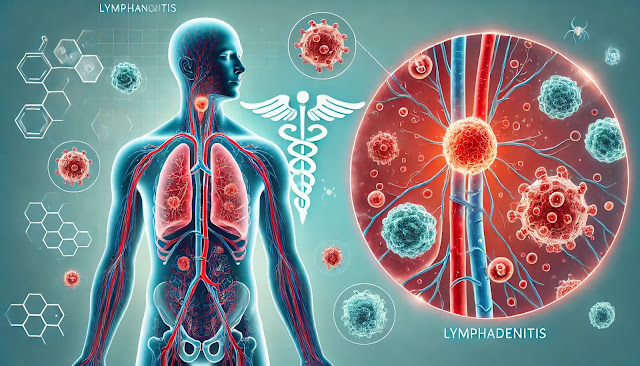Lymphadenitis: Understanding Causes, Symptoms, Diagnosis, and Treatment
1. Definition of Lymphadenitis
Lymphadenitis refers to the inflammation of the lymph nodes, which are an essential part of the body’s immune system. These small, bean-shaped glands help filter harmful substances, including bacteria and viruses, from the body. When these nodes become inflamed, swollen, or tender, it typically indicates that the body is fighting off an infection or other underlying condition. Lymphadenitis can be localized to one area or can affect multiple regions depending on the infection or cause.
2. Causes of Lymphadenitis
Lymphadenitis is most often caused by infections. When the body detects an infection, the lymph nodes in the affected area may swell as they produce more immune cells to help fight the invading pathogen. Common causes include:
- Bacterial infections: Bacteria such as Streptococcus and Staphylococcus are common causes, particularly in cases of throat infections or skin infections.
- Viral infections: Viruses like Epstein-Barr (which causes mononucleosis), HIV, and the common cold can cause lymph node swelling.
- Fungal infections: Fungal infections, although less common, can also lead to lymphadenitis.
- Autoimmune diseases: Conditions like rheumatoid arthritis and lupus can cause chronic lymphadenitis.
- Cancer: In some cases, swollen lymph nodes may be a sign of cancer, such as lymphoma or leukemia.
3. Symptoms of Lymphadenitis
The symptoms of lymphadenitis can vary based on the severity of the infection and the underlying cause. Common symptoms include:
- Swollen, tender lymph nodes: These are usually found in the neck, armpits, or groin.
- Fever and chills: Accompanying a bacterial or viral infection.
- Redness or warmth: The skin over the swollen lymph nodes may be red and warm to the touch.
- Pain: The affected area may feel painful when touched or even without touch in more severe cases.
- General fatigue: Feeling tired or unwell is common when the body is fighting an infection.
4. Diagnosis of Lymphadenitis
Diagnosing lymphadenitis typically involves a combination of physical examinations and diagnostic tests:
- Physical examination: Your doctor will check for swollen lymph nodes and evaluate their size, tenderness, and consistency.
- Blood tests: These help determine if there is an infection and identify the type of infection.
- Imaging tests: Ultrasound or CT scans may be used to get a clearer picture of the lymph nodes and surrounding tissues.
- Biopsy: In some cases, a small sample of the lymph node may be taken for laboratory analysis to rule out cancer or other serious conditions.
5. Treatment of Lymphadenitis
Treatment of lymphadenitis depends on the underlying cause:
- Antibiotics: If the lymphadenitis is caused by a bacterial infection, antibiotics may be prescribed to clear the infection.
- Antiviral or antifungal medications: For viral or fungal infections, appropriate medications may be prescribed.
- Pain relief: Over-the-counter pain relievers such as ibuprofen or acetaminophen can help reduce pain and inflammation.
- Drainage: If the lymph node becomes abscessed, surgical drainage may be necessary to remove pus and prevent further infection.
- Supportive care: Rest, hydration, and maintaining proper nutrition can help your body recover faster.
6. Prevention of Lymphadenitis
Preventing lymphadenitis largely involves preventing infections. Key prevention strategies include:
- Good hygiene: Wash your hands frequently, especially after touching your face or common surfaces.
- Vaccinations: Stay up to date with vaccinations for diseases like influenza, tuberculosis, and others.
- Avoid close contact with infected individuals: If someone is contagious, avoid direct contact to prevent the spread of infections.
7. Diet and Lifestyle for Managing Lymphadenitis
While there isn’t a specific diet to cure lymphadenitis, a healthy immune system can support faster recovery:
- Balanced diet: A diet rich in fruits, vegetables, lean proteins, and whole grains can boost your immune system.
- Stay hydrated: Drinking plenty of fluids can help your body fight infection.
- Avoid smoking and alcohol: These can weaken your immune system and slow down recovery.
- Get plenty of rest: Resting gives your body the energy it needs to recover from illness.
8. Exercise and Rehabilitation
During recovery from lymphadenitis, light exercises can help improve circulation and reduce stiffness:
- Gentle stretching or walking: Can help alleviate stiffness around swollen lymph nodes.
- Avoid strenuous activities: Until your doctor gives you the all-clear, avoid heavy exercise or activities that strain your body.
- Rehabilitation: In cases of chronic lymphadenitis or after surgery, physical therapy may be recommended to regain strength and mobility.
Conclusion
Lymphadenitis is a common condition often caused by infections that result in swollen and tender lymph nodes. Early diagnosis and proper treatment are essential to managing symptoms and preventing complications. Maintaining good hygiene, following a healthy lifestyle, and seeking medical advice when needed can help in preventing and managing this condition. This blog provides general information and should not replace professional medical advice. For accurate diagnosis and personalized treatment, consult a healthcare provider.




%20where%20a%20person%20stands%20with%20their%20knees%20touching%20while%20their%20feet%20remain%20apart,%20creating%20an%20'X'.png)
.%20The%20image%20should%20depict%20a%20human%20figure%20from%20.webp)



%20in%20a%20medical%20context.%20Show%20symptoms%20like%20constant%20throat%20clearing,%20cough,%20sore%20throat,.webp)
%20in%20a%20medical%20cont.webp)
Comments
Post a Comment